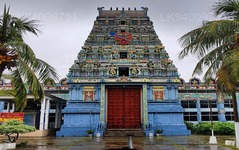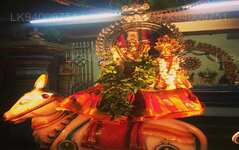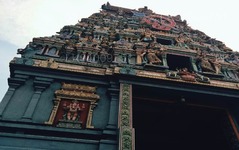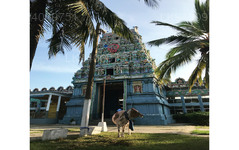
콜롬보 시
스리랑카의 수도 콜롬보는 전통과 현대가 조화를 이루는 역동적인 도시입니다. 식민지 시대 건축물, 활기 넘치는 시장, 그리고 고요한 불교 사원을 만나볼 수 있습니다. 다채로운 요리, 성장하는 스카이라인, 그리고 아름다운 해변을 자랑하는 콜롬보는 비즈니스, 문화, 관광의 중심지로서 스리랑카의 경이로움을 탐험할 수 있는 관문 역할을 합니다.
Old Kathiresan Temple
Old Kathiresan Temple is a massive century old Hindu cultural site hidden amongst the busy business centre of Colombo City. It is located in Colombo 4 (Bambalapitiya) a little further on from the twin Hindu Temples opposite the Bambalapitiya Apartment Complex, and is adjoining Vajira Road.
Kathiresan (Light Rayed Lord) is another name for Lord Murugan, the Hindu God of Light, Love and War. Wen the temple was initially built, Lord Murugan was considered the main deity of the temple and enshrined in the central shrine. As such it gained the name Kathiresan Temple. With the building of another Murugan Temple nearby (the one directly opposite the apartments mentioned before), which was named New Kathiresan Temple,, this one began to be called Old Kathiresan temple to differentiate it. In addition, with time the temple,s Ganesha shrine became highly popular and earned the place the name Vajira Road Pillaiyar (Ganesha) Kovil, or ‘Vijira Pilaiyar Kovil,..
While the Old Kathiresan Temple is quite old and has a long history, it remains a quiet place of peace and solace. One of the reasons for this is that it is still not as popular as the nearby temples, as the temple only opened back up recently after a very long stint of renovations. For the youth of Colombo, this temple is pretty much unknown place as it has remained under construction for over a decade.
However, now that it has opened its doors to devotees once again, the work done on the temple has been found to be amazing. A beautiful green lawn and a tall colorful temple tower welcome The new coats of paint add a touch of color to the temple,s original structure. Many new additions have been made with an impeccable eye to detail. The deities in the shrines are beautifully carved and in some shrines, where they were initially too small or crudely made, replaced with black granite statues from India done by master stone carvers.
Visiting the Temple
When visiting Hindu temples it is a custom to cleanse yourself properly and wear clean washed clothes when visiting, as they are holy places. You can also take offerings such as flowers, incense sticks, garlands, silk or satin cloth for draping the deities, etc. There are usually garland sellers near the entrance of the temple who sell many types of offerings.
Before entering the temple remove your footwear and hand it over to the person who handles this near the entrance. Wash your feet at the tap close to where your footwear is kept, to cleanse them. Also wash your offerings if they are washable (garlands or flowers), or sprinkle some fresh clean water if not.
Once you enter you will be faced with the main shrine. After giving your offerings you can buy a ticket for a pooja. They will ask for your name and astrological birth star. If you don’t know your star, you can just give your name. Then there will be a pooja and some blessed pooja objects (a banana on a betel leaf, holy ash, flowers from the pooja, etc) will be given to you to take home.
You can then move clockwise around the rest of the temple looking at the other shrines, such as the Ganesha and Shiva shrines. You can also request to do poojas at the other shrines with purchased tickets from the counter inside if you wish. Towards the back you will come to a shrine with some recent Indian saints: Sai Baba and Shirti Sai Baba. If you are a believer in these saints, you may enjoy a visit here.
There are also some cows and roosters at the temple. The cows are used to provide milk for the poojas, while the roosters are kept because they have special significance to the main deity of the temple Murugan. According to legend, Lord Murugan battled an evil demon to save the people of heaven and earth. During the battle the demon attempted to escape by hiding in the form of a mango tree. But it was discovered, and Murugan split the demon into two with his spear. One of the split parts turned into a peacock, and the other a rooster. The peacock became Murugan,s vehicle for travel, while the colorful rooster became his flag. Hence, this Murugan temple – like many others – has roosters walking around with great aplomb.
There is much to see and enjoy at this temple. It makes for a pleasant space of worship and solace in a city of bustling tradespeople and workers.
콜롬보 지구 소개
콜롬보는 스리랑카에서 가장 큰 도시이자 상업 중심지입니다. 섬의 서쪽 해안에 위치하며 수도인 스리자야와르데네푸라코테와 인접해 있습니다. 콜롬보는 현대적인 삶과 식민지 시대 건물 및 유적이 조화를 이루는 활기 넘치는 도시로, 인구는 647,100명입니다. 콜롬보, 감파하, 칼루타라 지구로 구분되는 콜롬보 수도권은 약 5,648,000명의 인구를 보유하고 있으며, 면적은 3,694.20km²입니다. 콜롬보는 다민족, 다문화 도시입니다. 스리랑카에서 인구가 가장 많은 도시로, 시 경계 내에 642,163명이 거주합니다. 콜롬보의 인구는 주로 싱할라족, 무어족, 타밀족 등 다양한 민족이 혼합되어 있습니다. 이 도시에는 중국, 포르투갈, 네덜란드, 말레이, 인도계 주민들로 구성된 소규모 공동체와 수많은 유럽계 외국인들이 거주하고 있습니다. 스리랑카 기업의 대다수는 콜롬보에 본사를 두고 있습니다. 화학, 섬유, 유리, 시멘트, 가죽 제품, 가구, 보석류 등의 산업이 이곳에 있습니다. 시내 중심부에는 남아시아에서 두 번째로 높은 건물인 세계 무역 센터가 있습니다.
서부 지방에 대하여
서부 주는 스리랑카에서 인구 밀도가 가장 높은 주입니다. 입법 수도인 스리자야와르데네푸라코테와 국가의 행정 및 비즈니스 중심지인 콜롬보가 있습니다. 서부 주는 콜롬보(642km²), 감파하(1,386.6km²), 칼루타라(1,606km²)의 세 개의 주요 지구로 나뉩니다. 스리랑카의 경제 중심지인 서부 주에는 모든 주요 국내 및 국제 기업과 유명 디자이너 및 대형 유통업체가 자리 잡고 있습니다. 따라서 서부 주에서 쇼핑을 즐길 준비를 하세요. 모든 주에서 인구가 가장 많은 서부 주에는 섬의 거의 모든 주요 교육 기관이 위치해 있습니다. 이 지방의 대학으로는 콜롬보 대학, 스리자야와르데네푸라 대학, 켈라니야 대학, 스리랑카 오픈 대학, 스리랑카 불교 및 팔리어 대학, 존 코텔라왈라 국방 대학, 모라투와 대학이 있습니다. 서부 지방에는 국립, 지방, 사립 및 국제 학교를 포함하여 전국에서 가장 많은 학교가 있습니다.










































